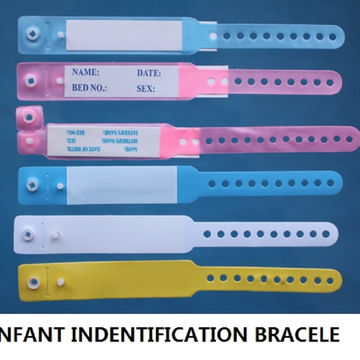The Duty of Patient Identification Band in Guaranteeing Accurate Medical Records
The Duty of Patient Identification Band in Guaranteeing Accurate Medical Records
Blog Article
Enhancing Individual Care With Reliable Recognition Bands
The implementation of effective recognition bands is a critical component in boosting individual treatment within medical care setups. As the landscape of person recognition progresses, one must consider the implications of these systems on overall healthcare shipment and individual end results.
Significance of Client Identification
Making sure accurate patient identification is important in health care settings, as it straight affects the safety and security and high quality of care supplied. Misidentification can bring about major errors, including administering the wrong medication, doing inaccurate procedures, or miscommunicating important patient information. Such mistakes not only threaten person safety but can also result in lawful ramifications and lowered count on medical care systems.
Efficient patient identification is basic to establishing a protected atmosphere where individuals get ideal and customized care. It promotes the accurate documentation of clinical histories, allergic reactions, and therapy plans, making certain that health care providers have accessibility to necessary information in all times. Additionally, durable recognition procedures aid enhance interaction among clinical staff, boosting partnership and lowering the danger of blunders.

Kinds Of Recognition Bands
Identification bands play a critical duty in preserving exact patient documents and improving security within healthcare settings. Various types of recognition bands are made use of to satisfy the particular requirements and requirements of various person populaces.

An additional type is the ankle joint band, which is especially useful for infants and babies, making certain that identification remains undamaged even during care treatments. Specialized bands, such as those for allergic reaction informs or fall risk signs, supply additional layers of security by attracting immediate focus to important client problems.
Lately, electronic identification bands have actually gained popularity, integrating barcodes or RFID modern technology that can be scanned to promptly fetch patient data. These bands enhance operations and lessen the danger of human mistake throughout person recognition procedures.
Advantages of Effective Recognition
Effective recognition of patients through the use of identification bands contributes considerably to general individual safety and security and care top quality. By making sure that each person is properly determined, medical care providers can effectively match clinical treatments and treatments to the proper person, minimizing the risk of errors. This is particularly vital in environments with high client turnover, where the potential for misidentification is greater.
Furthermore, efficient identification bands boost interaction among healthcare teams. Exact and clear individual recognition fosters cooperation and makes certain that all staff member know a person's certain demands and medical background. This communication is vital for delivering coordinated care, particularly in emergency circumstances where time is vital.

Eventually, efficient identification through making use of recognition bands not just safeguards clients however also promotes a culture of safety within medical care centers (Patient Identification Band). By focusing on exact identification, health care organizations can boost results and boost the total individual experience
Applying Recognition Equipments
While the importance of patient recognition is well acknowledged, the implementation of robust identification systems poses a complicated challenge for health care organizations. Developing effective recognition systems requires an extensive approach, encompassing innovation, personnel training, and procedure integration.
First, companies have to choose suitable recognition innovations, such as barcode scanning, RFID, or biometric systems. Patient Identification Band. These technologies ought to be reviewed based on price, usability, and compatibility with existing framework. A pilot program can assist determine possible issues before full-blown application
Following, extensive training for team is vital. All employees should understand the relevance of exact client identification and excel in making use of the picked innovations. Routine training updates and analyses can strengthen ideal methods and make certain ongoing compliance.
Furthermore, medical care companies must create standardized treatments for patient recognition throughout all divisions, minimizing disparities and enhancing communication. Routine audits can assist recognize moved here voids in adherence to these protocols.

Eventually, a reliable execution of recognition systems not only improves individual security yet also fosters a culture of accountability and persistance within medical care setups, ensuring constant and reputable individual treatment.
Future Trends in Person Recognition
Improvements in modern technology are readied to revolutionize client identification practices in medical care settings. The assimilation of biometric identification techniques, such as fingerprinting and face recognition, is anticipated to boost precision and protection. These modern technologies can significantly minimize the risk of misidentification, making certain that individuals receive the right treatments and medicines.
Furthermore, the execution of blockchain innovation for patient documents is gaining grip. This decentralized method can provide a tamper-proof and protected method for handling patient identifications, therefore improving access to important details across different doctor.
One more pattern is the enhancing use mobile health and wellness applications that utilize QR codes for client recognition. These applications permit for real-time updates and easy accessibility to client data, equipping medical care specialists to make enlightened choices swiftly.
Additionally, expert system (AI) is positioned to play an essential function in assessing patient recognition information, identifying patterns, and anticipating possible identification mistakes prior to they occur.
As these innovations advance, they assure not only to enhance individual security however additionally to enhance the general effectiveness of medical care shipment systems. Welcoming these developments will certainly be essential for future-proofing individual care techniques.
Conclusion
To conclude, efficient identification bands are necessary for enhancing patient safety and care quality within healthcare setups. By lessening the threats linked with misidentification, these bands promote accurate and timely details retrieval, ultimately enhancing communication among doctor. The implementation of robust recognition systems not just promotes a culture of security but additionally placements health care establishments to adjust to future fads in individual identification technology, making certain optimal end results for individuals in diverse medical atmospheres.
As the landscape of patient recognition progresses, one should consider the effects of these systems on read review overall medical care distribution and client outcomes.Effective individual identification is basic to establishing a safe and secure setting where clients obtain proper and personalized care. Eventually, focusing on reliable individual identification approaches not only cultivates a culture of safety yet likewise adds to improved individual results and general complete satisfaction with medical care services.
Efficient recognition of clients through the use of recognition bands adds her comment is here dramatically to general client safety and security and care top quality. The application of durable recognition systems not just promotes a society of security yet additionally positions healthcare organizations to adjust to future trends in individual identification modern technology, guaranteeing ideal end results for people in diverse professional atmospheres.
Report this page